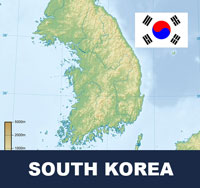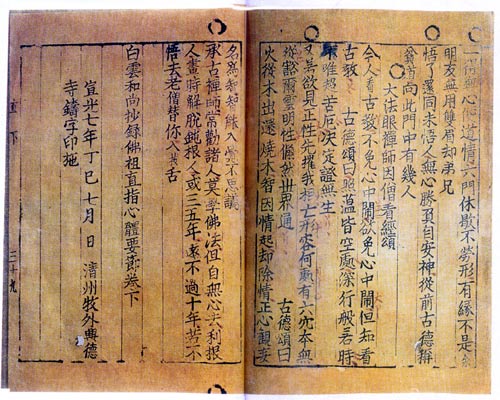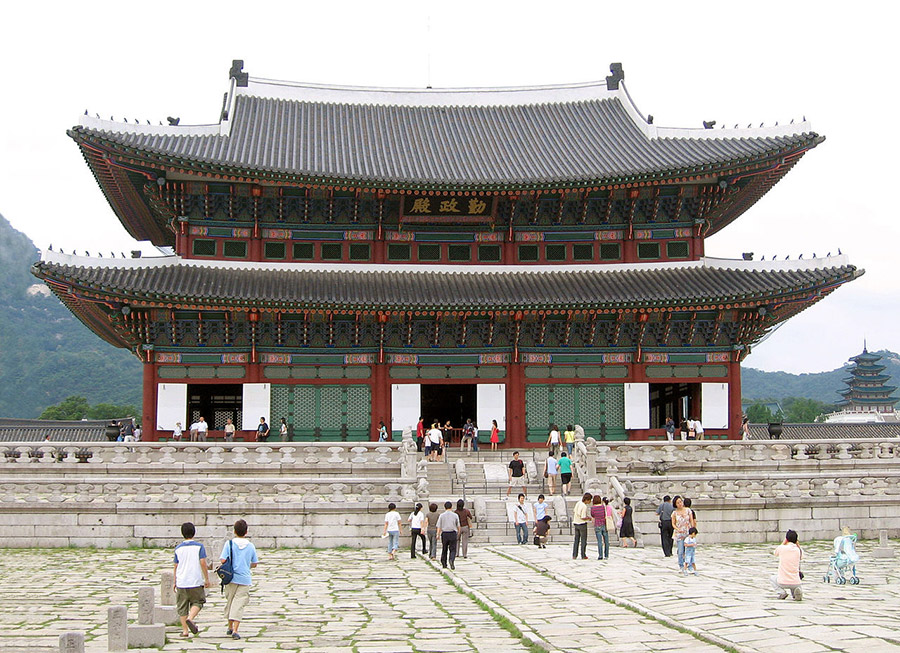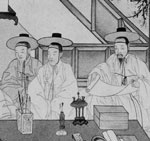Taekwondo 태권도Taekwondo Preschool
Joseon was a Korean state founded by Taejo Yi Seong-gye that lasted for approximately five centuries, from July 1392 to October 1897. It was founded following the aftermath of the overthrow of the Goryeo Dynasty in what is today the city of Kaesong. Early on, Korea was retitled and the capital was relocated to modern-day Seoul. View Joseon Era 조선 »

South Korea
( 대한민국 )
Korea (Korean: 한국; Hanja: 韓國), called Hanguk in South Korea and Chosŏn in North Korea, is an East Asian territory that is divided into two distinct sovereign states, North Korea and South Korea.
South Korea, officially the Republic of Korea (Hangul: 대한민국; Hanja: 大韓民國; Daehan Minguk; lit. "The Republic of Great Han"), is a country in East Asia, constituting the southern part of the Korean Peninsula. The name Korea is derived from Goryeo (also spelt Koryo), a dynasty which ruled in the Middle Ages. It shares land borders with North Korea to the north, and oversea borders with China to the west and Japan to the east. South Korea lies in the north temperate zone with a predominantly mountainous terrain. Roughly half of the country's 50 million people reside in the metropolitan area surrounding its capital, the Seoul Capital Area, which is the third largest in the world with over 25 million residents.
Korea was inhabited as early as the Lower Paleolithic period and its civilization begins with the founding of Gojoseon in 2333 BC. After the unification of the Three Kingdoms of Korea in 668, Korea enjoyed over a millennium of relative tranquility under dynasties lasting for centuries in which its trade, culture, literature, science and technology flourished. It became part of the Japanese Empire in 1910 and after its defeat in 1945, Korea was divided into Soviet and U.S. zones of occupation, with the latter becoming the Republic of Korea in 1948. Although the United Nations passed a resolution declaring the Republic to be the only lawful government of Korea, a communist regime was soon set up in the North that invaded the South in 1950, leading to the Korean War that ended de facto in 1953, with peace and prosperity settling-in thereafter.
Between 1962 and 1994, South Korea's tiger economy grew at an average of 10% annually, fueled by annual export growth of 20%, in a period called the Miracle on the Han River that rapidly transformed it into a high-income advanced economy and the world's 11th largest economy by 1995. Today, South Korea is the eighth largest country in international trade, a regional power with the world's 10th largest defence budget and founding member of the G-20 and APEC. Civilian government replaced military rule in 1987 and it has since evolved into a vibrant democracy ranked second in Asia on the Democracy Index. In 2009, South Korea became the world's first former aid recipient to join the OECD's Development Assistance Committee, becoming a major donor. Its pop culture has considerable influence in Asia and expanding globally in a process called the Korean Wave.
South Korea is a developed country ranked 12th in the Human Development Index, while in terms of average wage, it has Asia's highest income and the world's 10th highest income. It ranks highly in education, quality of healthcare, rule of law, ease of doing business, government transparency, job security, tolerance and inclusion. 64% of 25-34 year old Koreans hold a tertiary education degree, the highest in the OECD. The most innovative country as measured by the Bloomberg Innovation Quotient, South Korea is the world's seventh largest exporter, driven by high-tech multinationals such as Samsung, Hyundai-Kia and LG. South Korea has global leadership in advanced technology such as the world's fastest Internet connection speed, ranking first in the ICT Development Index, e-Government, 4G LTE penetration and second in smartphone penetration.
Etymology
The name Korea derives from Goryeo, itself referring to the ancient kingdom of Goguryeo, the first Korean dynasty visited by Persian merchants who referred to Koryŏ (Goryeo; 고려) as Korea. The term Koryŏ also widely became used to refer to Goguryeo, which renamed itself Koryŏ in the 5th century. (The modern spelling, "Korea", first appeared in late 17th century in the travel writings of the Dutch East India Company's Hendrick Hamel.). Despite the coexistence of the spellings Corea and Korea in 19th century publications, some Koreans believe that Japan, around the time of the Japanese occupation, intentionally standardised the spelling on Korea, making Japan appear first alphabetically.
After Goryeo fell in 1392, Joseon became the official name for the entire territory, though it was not universally accepted. The new official name has its origin in the ancient country of Gojoseon (Old Joseon). In 1897, the Joseon dynasty changed the official name of the country from Joseon to Daehan Jeguk (Korean Empire). The name Daehan, which means "great Han" literally, derives from Samhan (Three Hans). However, the name Joseon was still widely used by Koreans to refer to their country, though it was no longer the official name. Under Japanese rule, the two names Han and Joseon coexisted. There were several groups who fought for independence, the most notable being the Daehan Minguk Imsi Jeongbu.
Following the surrender of Japan, in 1945, the Republic of Korea (Daehan Minguk) was adopted as the legal name for the new country. Since the government only controlled the southern part of the Korean Peninsula, the informal term South Korea was coined, becoming increasingly common in the Western world. While South Koreans use Han (or Hanguk) to refer to the entire country, North Koreans use Joseon as the name of the country.
Before the Division
Korean history begins with the founding of Chosun (often known as "Gojoseon" to prevent confusion with another dynasty founded in the 14th century; the prefix Go- means 'older,' 'before,' or 'earlier') in 2333 BC by Dangun, according to Korean foundation mythology. Gojoseon expanded until it controlled northern Korean Peninsula and some parts of Manchuria. After many conflicts with the Chinese Han Dynasty, Gojoseon disintegrated, leading to the Proto–Three Kingdoms of Korea period.

In the early centuries of the Common Era, Buyeo, Okjeo, Dongye, and the Samhan confederacy occupied the peninsula and southern Manchuria. Of the various states, Goguryeo, Baekje, and Silla grew to control the peninsula as Three Kingdoms of Korea. The unification of the Three Kingdoms by Silla in 676 led to the North South States Period, in which much of the Korean Peninsula was controlled by Unified Silla, while Balhae succeeded to have the control of northern parts of Goguryeo.
In Unified Silla, poetry and art was encouraged, and Buddhist culture thrived. Relationships between Korea and China remained relatively peaceful during this time. However, Unified Silla weakened under internal strife, and surrendered to Goryeo in 935. Balhae, Silla's neighbor to the north, was formed as a successor state to Goguryeo. During its height, Balhae controlled most of Manchuria and parts of Russian Far East. It fell to the Khitan in 926.
The peninsula was united by King Taejo of Goryeo in 936. Like Silla, Goryeo was a highly cultural state and created the Jikji in 1377, using the world's oldest movable metal type printing press. The Mongol invasions in the 13th century greatly weakened Goryeo. After nearly 30 years of war, Goryeo continued to rule Korea, though as a tributary ally to the Mongols. After the Mongolian Empire collapsed, severe political strife followed and the Goryeo Dynasty was replaced by the Joseon Dynasty in 1392, following a rebellion by General Yi Seong-gye.
Gyeongbok Palace is the largest of the Five Grand Palaces built during the Joseon Dynasty. King Taejo declared the new name of Korea as "Joseon" in reference to Gojoseon, and moved the capital to Hanseong (old name of Seoul). The first 200 years of the Joseon Dynasty were marked by relative peace and saw the creation of Hangul by King Sejong the Great in the 15th century and the rise in influence of Confucianism in the country.
Between 1592 and 1598, Japan invaded Korea. Toyotomi Hideyoshi led the Japanese forces, but his advance was halted by Korean forces with assistance from Righteous army militias and Ming Dynasty China troops. Through a series of successful battles of attrition, the Japanese forces were eventually forced to withdraw, and subsequently signed a peace agreement with diplomats of Ming China. This war also saw the rise of Admiral Yi Sun-sin and his renowned "turtle ship". In the 1620s and 1630s, Joseon suffered from invasions by the Manchu which eventually extended to China as well.
After another series of wars against Manchuria, Joseon experienced a nearly 200-year period of peace. King Yeongjo and King Jeongjo particularly led a new renaissance of the Joseon Dynasty.
However, the latter years of the Joseon Dynasty were marked by a dependence on China for external affairs and isolation from the outside world. During the 19th century, Korea's isolationist policy earned it the name the "Hermit Kingdom". The Joseon Dynasty tried to protect itself against Western imperialism, but was eventually forced to open trade. After the First Sino-Japanese War and the Russo-Japanese War, Korea was occupied by Japan (1910–45). At the end of World War II, the Japanese surrendered to Soviet and U.S. forces who occupied the northern and southern halves of Korea, respectively.

After the Division
Despite the initial plan of a unified Korea in the 1943 Cairo Declaration, escalating Cold War antagonism between the Soviet Union and the United States eventually led to the establishment of separate governments, each with its own ideology, leading to Korea's division into two political entities in 1948: North Korea and South Korea.
In the South Syngman Rhee, an opponent of communism, who had been backed and appointed by the United States as head of the provisional government, won the first presidential elections of the newly declared Republic of Korea in May. In the North, a former anti-Japanese guerrilla and communist activist, Kim Il-sung was appointed premier of the Democratic People's Republic of Korea in September. In October the Soviet Union declared Kim Il-sung's government as sovereign over both parts, quickly followed by the UN General Assembly in December. The UN, which had a Western majority until 1955, declared Rhee's government as "a lawful government having effective control and jurisdiction over that part of Korea where the UN Temporary Commission on Korea was able to observe and consult" and the Government "based on elections which was observed by the Temporary Commission" in addition to a statement that "this is the only such government in Korea." Both leaders began an authoritarian repression of their political opponents inside their region, seeking for a unification of Korea under their control. While South Korea's request for military support was denied by the United States, North Korea's military was heavily reinforced by the Soviet Union.
On June 25, 1950, North Korea invaded South Korea, sparking the Korean War, the Cold War's first major conflict that continued until 1953. At the time, the Soviet Union had boycotted the United Nations (UN), thus forfeiting their veto rights. This allowed the UN to intervene in a civil war when it became apparent that the superior North Korean forces would unify the entire country. The Soviet Union and China backed North Korea, with the later participation of millions of Chinese troops. After huge advances on both sides, and massive losses among Korean civilians in both the north and the south, the war eventually reached a stalemate. The 1953 armistice, never signed by South Korea, split the peninsula along the demilitarized zone near the original demarcation line. No peace treaty was ever signed, resulting in the two countries remaining technically at war. Over 1.2 million people died during the Korean war.
In 1960, a student uprising (the "April 19 Revolution") led to the resignation of the autocratic, corrupt President Syngman Rhee. A period of political instability followed, broken by General Park Chung-hee's military coup (the "5.16 coup d'état") against the weak and ineffectual government the next year. Park took over as president until his assassination in 1979, overseeing rapid export-led economic growth as well as political repression. Park was heavily criticised as a ruthless military dictator, although the Korean economy developed significantly during his tenure. The government developed the nation-wide expressway system, the Seoul subway system, and laid the foundation for economic development during his tenure.
The years after Park's assassination were marked again by political turmoil, as the previously repressed opposition leaders all campaigned to run for president in the sudden political void. In 1979 there was a Coup d'état of December Twelfth by General Chun Doo-hwan. After the Coup d'état, Chun Doo-hwan planned to rise to power with several measures. On May 17, Chun Doo-hwan forced the Cabinet to expand martial law to the whole nation, which had previously not applied to the island of Jeju-do. The expanded martial law closed universities, banned political activities and further curtailed the press. Chun assumed the presidency by the event of May 17, triggering nationwide protests demanding democracy, in particular in the city of Gwangju, where Chun sent special forces to violently suppress the Gwangju Democratization Movement.
Chun subsequently created the National Defense Emergency Policy Committee and took the presidency according to his political plan. Chun and his government held Korea under a despotic rule until 1987, when a Seoul National University student, Park Jong-chul, was tortured to death. On June 10, the Catholic Priests Association for Justice revealed the incident, igniting huge demonstrations around the country. Eventually, Chun's party, the Democratic Justice Party, and its leader, Roh Tae-woo announced the 6.29 Declaration, which included the direct election of the president. Roh went on to win the election by a narrow margin against the two main opposition leaders, Kim Dae-Jung and Kim Young-Sam.
In 1988, Seoul hosted the 1988 Summer Olympics. It became a member of the Organization for Economic Co-operation and Development (OECD) in 1996. It was adversely affected by the 1997 Asian Financial Crisis. However, the country recovered and continue its economic growth, albeit at a slower pace.
In June 2000, as part of president Kim Dae-Jung's "Sunshine Policy" of engagement, a North–South summit took place in Pyongyang, the capital of North Korea. Later that year, Kim received the Nobel Peace Prize "for his work for democracy and human rights in South Korea and in East Asia in general, and for peace and reconciliation with North Korea in particular." However, because of discontent among the population for fruitless approaches to the North under the previous administrations and, amid North Korean provocations, a conservative government was elected in 2007 led by President Lee Myung-bak, former mayor of Seoul. More recently, Park Geun-hye won the South Korean presidential election, 2012.
In 2002, South Korea and Japan jointly co-hosted the 2002 FIFA World Cup. However, South Korean and Japanese relations later soured because of conflicting claims of sovereignty over the Liancourt Rocks ("Dokdo" in Korea), in what became known as the Liancourt Rocks dispute.
Government
Under its current constitution the state is sometimes referred to as the Sixth Republic of South Korea. Like many democratic states, South Korea has a government divided into three branches: executive, judicial, and legislative. The executive and legislative branches operate primarily at the national level, although various ministries in the executive branch also carry out local functions. Local governments are semi-autonomous, and contain executive and legislative bodies of their own. The judicial branch operates at both the national and local levels. South Korea is a constitutional democracy.
The South Korean government's structure is determined by the Constitution of the Republic of Korea. This document has been revised several times since its first promulgation in 1948 at independence. However, it has retained many broad characteristics and with the exception of the short-lived Second Republic of South Korea, the country has always had a presidential system with an independent chief executive. The first direct election was also held in 1948. Although South Korea experienced a series of military dictatorships from the 1960s up until the 1980s, it has since developed into a successful liberal democracy. Today, the CIA World Factbook describes South Korea's democracy as a "fully functioning modern democracy".
Demographics
South Korea is noted for its population density, which is 487 per square kilometer, more than 10 times the global average. Most South Koreans live in urban areas, because of rapid migration from the countryside during the country's quick economic expansion in the 1970s, 1980s and 1990s. The capital city of Seoul is also the country's largest city and chief industrial center. According to the 2005 census, Seoul had a population of 9.8 million inhabitants. The Seoul National Capital Area has 24.5 million inhabitants (about half of South Korea's entire population) making it the world's second largest metropolitan area and easily the most densely populated city in the OECD. Other major cities include Busan (3.5 million), Incheon (2.5 million), Daegu (2.5 million), Daejeon (1.4 million), Gwangju (1.4 million) and Ulsan (1.1 million).
The population has also been shaped by international migration. After World War II and the division of the Korean Peninsula, about four million people from North Korea crossed the border to South Korea. This trend of net entry reversed over the next 40 years because of emigration, especially to the United States and Canada. South Korea's total population in 1955 was 21.5 million, and today it is roughly 50,062,000.
South Korea is one of the most ethnically homogeneous societies in the world, with more than 99% of inhabitants having Korean ethnicity. Koreans call their society 단일민족국가, Dan-il minjok guk ga, "the single race society".
The percentage of foreign nationals has been growing rapidly. As of 2009, South Korea had 1,106,884 foreign residents, 2.7% of the population; however, more than half of them are ethnic Koreans with a foreign citizenship. For example, migrants from China (PRC) make up 56.5% of foreign nationals, but approximately 30% of the Chinese citizens in Korea are Joseonjok (조선족 in Korean), PRC citizens of Korean ethnicity. Regardless of the ethnicity, there are 28,500 US military personnel serving in South Korea, most serving a one-year unaccompanied tour (though approximately 10% serve longer tours accompanied by family), according to the Korea National Statistical Office. In addition, about 43,000 English teachers from English-speaking countries reside temporarily in Korea. Currently, South Korea has one of the highest rate of growth of foreign born population, with about 30,000 foreign born residences obtaining South Korean citizenship every year since 2010.
South Korea's birthrate was the world's lowest in 2009. If this continues, its population is expected to decrease by 13% to 42.3 million in 2050. South Korea's annual birthrate is approximately 9 births per 1000 people. However, the birthrate has increased by 5.7% in 2010 and Korea no longer has the world's lowest birthrate. According to a 2011 report from Chosun Ilbo, South Korea's total fertility rate (1.23 children born per woman) is higher than those of Taiwan (1.15) and Japan (1.21). The average life expectancy in 2008 was 79.10 years, which is 34th in the world. South Korea has the steepest decline in working age population of the OECD nations.
Religion
As of 2005, just under half of the South Korean population expressed no religious preference. Of the rest, most are Buddhist or Christian. According to the 2007 census, 29.2% of the population at that time was Christian (18.3% identified themselves as Protestants, 10.9% as Roman Catholics), and 22.8% were Buddhist. Other religions include Islam and various new religious movements such as Jeungsanism, Cheondoism and Wonbuddhism. The earliest religion practiced was Korean shamanism. Today, freedom of religion is guaranteed by the constitution, and there is no state religion.
Christianity is South Korea's largest religion, accounting for more than half of all South Korean religious adherents. There are approximately 13.7 million Christians in South Korea today, about 63% of Christians belong to Protestant churches, while about 37% belong to the Roman Catholic Church. The number of Protestant Christians have slowly decreased since the 1990s, while the number of Roman Catholics has rapidly increased since the 1980s. Presbyterian denominations are the biggest Christian denominations in South Korea. About 9 million people belongs to the 100 different Presbyterian churches, among the biggest denominations are the Presbyterian Church in Korea (HapDong), Presbyterian Church in Korea (TongHap), the Presbyterian Church in Korea (Koshin). South Korea is also the second-largest missionary-sending nation, after the United States.
Buddhism was introduced to Korea in the year 372. According to the national census as of 2005, South Korea has over 10.7 million Buddhists. Today, about 90% of Korean Buddhists belong to Jogye Order. Most of the National Treasures of South Korea are Buddhist artifacts. Buddhism became the state religion in some of Korean kingdoms since the Three Kingdoms Period, when Goguryeo adopted it as the state religion in 372, followed by Baekche (528). Buddhism had been the state religion of Unified Korea from North South States Period (not to be confused with the modern division of Korea) to Goryeo before suppression under the Joseon Dynasty in favor of Neo-Confucianism.
Fewer than 30,000 South Koreans are thought to be Muslims, but the country has some 100,000 resident foreign workers from Muslim countries, Bangladesh and Pakistan.
Korean shamanism, today known as Muism (religion of the mu [shamans]) or Sinism (religion of the gods) encompasses a variety of indigenous religious beliefs and practices of the Korean people and the Korean sphere. In contemporary South Korea, the most used term is Muism and a shaman is known as a mudang (무당, 巫堂) or Tangol (당골). Since the early 2000s, this religion has regained popularity among Koreans.

Korea ( 한국 )
Korea ( 한국 ) called Hanguk in South Korea and Chosŏn in North Korea, is an East Asian territory that is divided into two distinct sovereign states, North Korea and South Korea. Located on the Korean Peninsula, Korea is bordered by China to the northwest and Russia to the northeast. It is separated from Japan to the east by the Korea Strait and the Sea of Japan (East Sea). For more information View Korea ( 한국 ) »
There are five tenets defined in the International Taekwondo Federation (ITF) and several more in World Taekwondo (WT).
Integrity ( 염치 yeom-chi ): "Although it may be similar, this form of integrity takes on a more wider role then defined in the common dictionary. In taekwondo, integrity means not only to determine what is right or wrong but also having the conscience to feel guilt if one has done wrong and to have the integrity stand up for what is right." View Taekwondo Tenets »
RESOURCES
This article uses material from the Wikipedia article "South Korea", which is released under the Creative Commons Attribution-Share-Alike License 3.0.









